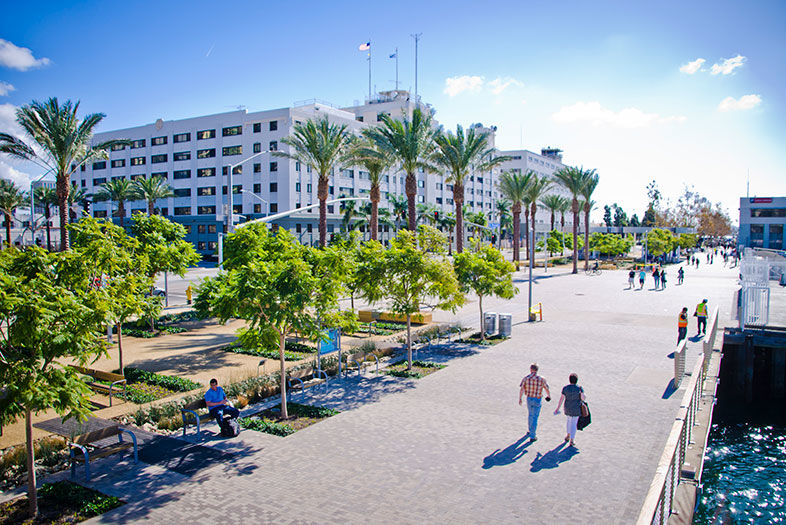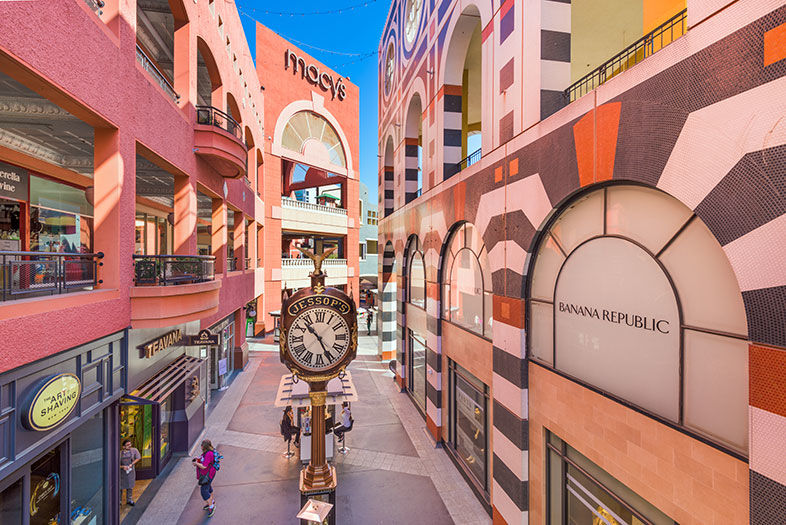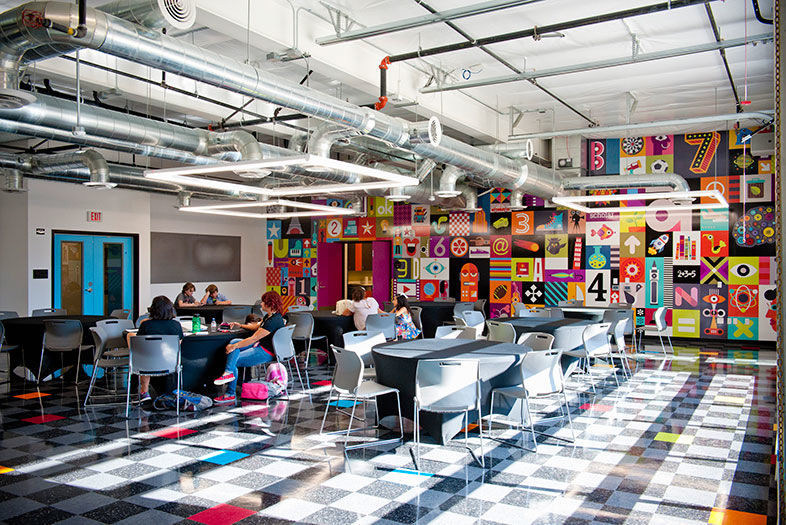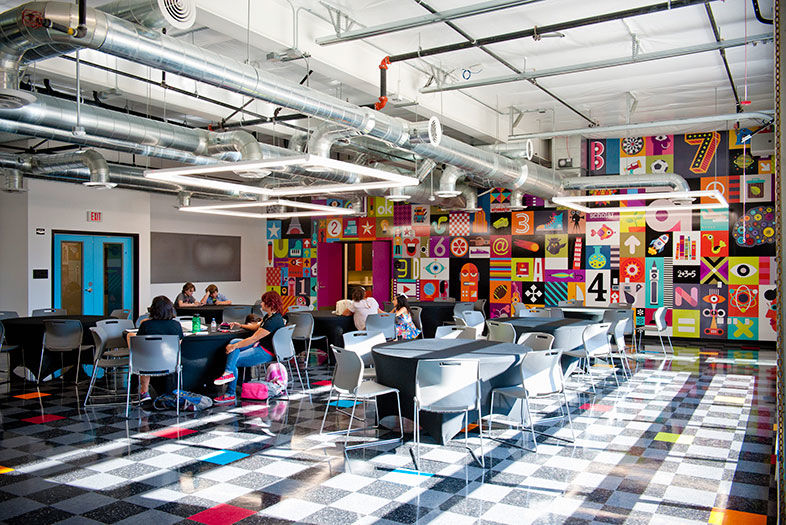Are there really K-12 schools downtown?
Downtown might seem like a haven for childless couples looking for a more urban lifestyle—nearly 90 percent of downtown residents do not have children living at home—but recent data shows that roughly 2,000 school-aged kids live in the 92101.
Parents have several elementary schools to choose from, including Washington Elementary in Little Italy, K-8 Urban Discovery Academy in the East Village, and the Museum School, located on the border of downtown and Bankers Hill. High schools include King-Chávez Community High, San Diego High, and e3 Civic High, which opened in 2013 on the sixth floor of the new Central Library.
San Diego Early/Middle College—also called East Village High School—is located on San Diego City College’s campus and gives 11th and 12th graders the chance to earn college credit while working toward a diploma.
What’s happening with the homeless?
Homelessness has always been an issue for downtown San Diego, but never quite to the extent it is now. A February count by the Downtown San Diego Partnership’s Clean & Safe outreach program found roughly a thousand people living on the streets, more than twice the number from five years ago.
The increase comes despite a number of initiatives aimed at reducing homelessness. In mid-2015, the city moved its emergency winter shelter program to St. Vincent de Paul’s Paul Mirabile Center in the East Village and expanded it year-round, with the goal of moving people from the shelter into more permanent housing.
There’s also Path San Diego’s Connections Housing, which opened in 2013 and provides 134 beds where people can stay for up to three months while looking for a more stable place to live. The newly rehabilitated Hotel Churchill, a century-old building along the C Street trolley tracks, includes 72 rooms for people coming off the street, and in 2015, homeless services provider Alpha Project opened East Village’s Alpha Square, which includes 203 units.
So, why are there still so many folks living on the street? No one has a definitive answer, but other large US cities with high housing costs have seen similar increases. As for the solution, everyone agrees that San Diego needs more affordable housing.
In the short-term, Mayor Kevin Faulconer, who hired Stacie Spector to be his point person on homelessness in October 2016, supports a multi-services center proposed for the corner of 20th and B streets—the current site of the city’s vehicle maintenance yard—which would include as many as 300 shelter beds. But some homelessness advocates believe the $12.5 million cost would be better spent on creating permanent housing.
Update: A proposed homeless center on city-owned land at 20th and B streets could hold as many as 500 shelter beds, 700 permanent housing slots and a slew of social services. Father Joe’s Villages has submitted a competing plan to spend $531 million on building 2,000 permanent housing units at 14th and Commercial streets. The city will continue to evaluate all proposals until May 5, then selected groups will be asked for a more detailed version.
What’s significant about UC San Diego opening a downtown campus?
A renowned university attracts global attention, talent, and business. All major cities have a university downtown. Boston alone is home to 35 colleges, universities, and community colleges. Our downtown has never had a major research university, but that will change in about three years, when UC San Diego opens a downtown campus.
“We have this great education spine from City College in the north to e3 at the library, Thomas Jefferson, NewSchool, FIDM, and Urban Discovery Academy,” explains David Malmuth, whose IDEA District will be home to the new campus. “It’s an interesting, diverse mix of educational institutions—but the missing piece is a university.” The local thinking seems to be that what UCSD did for the Torrey Pines Mesa, it could also do for downtown. The $42-million campus and four-story facility will also engage people who don’t normally get out to La Jolla.
“The downtown facility will give students and families from San Diego’s diverse neighborhoods a window into what a world-class university has to offer. What will be especially transformative is the connection that the new UCSD trolley line will provide between the urban core and the campus when it opens in 2021. These transportation links are important as San Diego comes of age and they enhance our commitment as a region to both excellence and inclusivity,” says Mary Walshok, dean of UCSD Extension. The new campus will stand across the street from the trolley stop at Park Boulevard and Market Street in the East Village.

FAQ: The Answers to 7 Burning Questions about Downtown
What’s up with the waterfront revamp?
It’s been nearly three years since the completion of Phase One of the North Embarcadero Visionary Plan, a multipart project to beautify San Diego’s waterfront. The first phase included Waterfront Park, which added underground parking, interactive fountains, and an innovative playground area. Other upgrades included a public esplanade, jacaranda grove (the official tree of San Diego), and pavilion with a café and information center designed by world-renowned artist Pae White.
The San Diego Unified Port District is also making the area more pedestrian and bike friendly: In Phase One, they narrowed part of North Harbor Drive to slow down automobile traffic. They will continue to focus on the areas from B Street Pier to Laurel Street and from Navy Pier to G Street.
But the biggest changes to the waterfront will come via Seaport Village. In November, the Port District selected development group 1HWY1 to create “Seaport San Diego.” A massive project with a $1.2-billion price tag and a long list of public amenities, it will include a 151,000-square-foot aquarium, a 480-foot observation tower, and more than 300,000 square feet of restaurant and retail space. To make the most of the waterfront setting, the plan envisions a sandy beach along Embarcadero Marina Park North, wetlands-restoration project, and large public plaza that would include a “floating” stage for movie screenings and live music performances. The plan will also add more than 1,000 hotel rooms, including a “Yotel” by the UK’s YO! Company, which specializes in tech-savvy “micro-rooms” inspired by Japanese hotels’ efficient use of small spaces.
What’s the fate of Horton Plaza?
When it debuted in 1985, Horton Plaza was a real win for downtown. “It was revolutionary for its time, a great leap forward in terms of driving more retail and restaurants,” says Michael Trimble, executive director of the Gaslamp Quarter Association. Even San Diego Magazine praised the mall in early articles, citing its “whiff of the Mediterranean” thanks to architect Jon Jerde’s “light-hearted design.” But downtown has changed, and so have shoppers. “We’ve come a long way since 1985,” Trimble adds. “Fifth Avenue has grown up.”
Horton Plaza Park reopened in May 2016 with new public art and live entertainment, which brought the plaza a little boost. But the mall itself has struggled. Nordstrom closed its doors in August, leaving behind a noticeable vacancy.

FAQ: The Answers to 7 Burning Questions about Downtown
The Overture
The main problem, according to developers, lies with the inward-facing design. “People don’t want to go to the mall anymore,” Trimble explains. “They want to be outside.”
For its part, Westfield, which owns and operates the mall, remains committed to its “next chapter.” VP of Marketing Communications Zach Eichman says, “The company envisions Horton Plaza as a truly fashionable front door to downtown’s Gaslamp Quarter and a modern urban oasis.”
One can infer this vision might look something like the $600-million transformation currently underway at Westfield UTC, with mixed-use spaces, first-to-market retailers, and restaurants all part of the plan. But nothing has been officially presented for Horton Plaza yet. For now, it seems downtowners are left with the Cinnabon and multilevel windowless Macy’s. Here’s hoping they write the next chapter soon.
Whatever happened to the old central library?
The steel-lattice dome of the San Diego Central Library has been a part of the downtown skyline for four years now, but the library’s former home on Eighth Avenue and E Street is still vacant.
Last spring, Civic San Diego put out a call for a developer to rehabilitate the 63-year-old building into a space for entrepreneurs, small businesses, or arts organizations. Several architects and real estate consultants visited the old library for inspiration on how to transform it. Then a year went by without any news about the building’s fate.
A spokeswoman from the mayor’s office says the proposal to redevelop the building into an incubator was withdrawn because the city wanted to evaluate other potential uses for it. Civic San Diego confirmed there was no plan for the old library at this time.
Why has a landmark building been left to decay into an eyesore?
Though it’s in a prime location, the old library isn’t an easy sell to a developer: It needs a lot of work. Costs to upgrade the aging infrastructure were estimated at $82 million, there’s asbestos to remove, and the building’s designation as historically significant means it can’t just be demolished—the terrazzo sidewalk and parts of the original architecture must remain.
Let’s hope a plan for the library is in the works, and that an intrepid architect or real estate company is up for the challenge. There are so many possible uses for it: Everything from a coworking center or homeless shelter to affordable housing or even a police evidence storage space has been suggested. It shouldn’t become another blighted block.
What’s the latest on the C Street Revitalization?
Psst: C Street is the one with the trolley going down it, parallel to Broadway (which was once called D Street). In many modern cities, a street with a trolley would be lined with trees and retail and have tons of people strolling and hopping on and off the train. But in San Diego, all is quiet. The addition of twinkle lights: not cutting it.
Leading the charge—or perhaps garnering the most attention—is a project called The Overture, an homage to the site’s 1923 origin as a theater. Overture received its final approval last month after four years of planning, marking the beginning of two to three years of construction. The all-glass, illuminated building will consist of 282 housing units. “That’s about 560 bodies coming in and out daily,” says Joseph Martinez, principal architect at Martinez + Cutri. Downtowners can expect extra-wide, 22-foot sidewalks, a double row of staggered trees, and retail on the bottom floor.
Between the Rey, the Overture, and a handful of other new or upcoming buildings, Martinez says that C Street’s foot traffic will soon increase by about 2,500 people. His firm alone has projects in the works for 2019, 2020, and 2021, all of which will help make C Street come alive.

FAQ: The Answers to 7 Burning Questions about Downtown
Urban Discovery Academy














